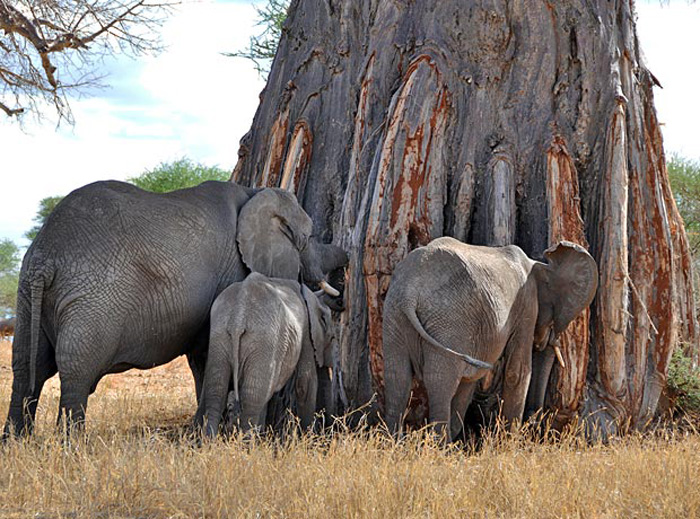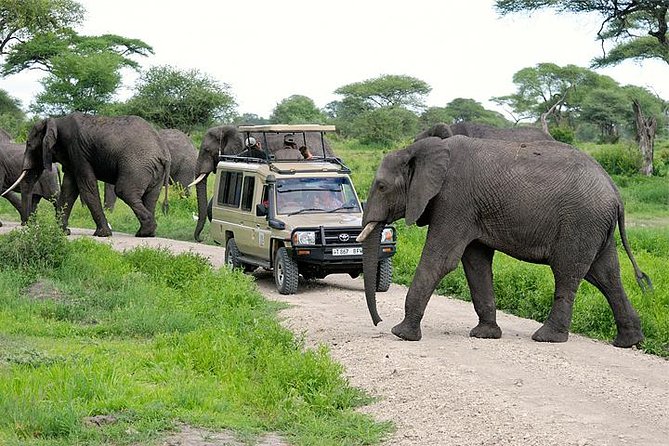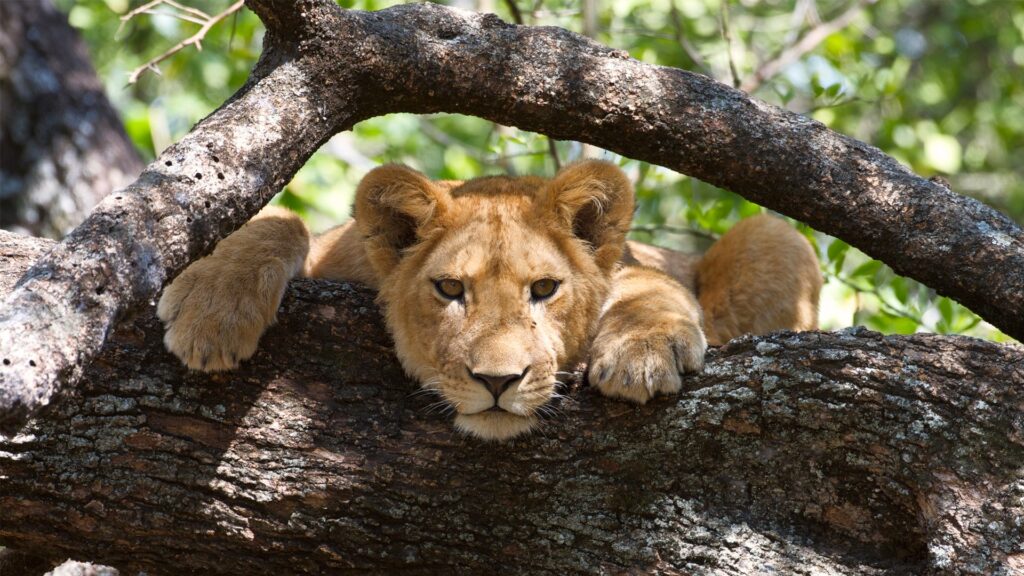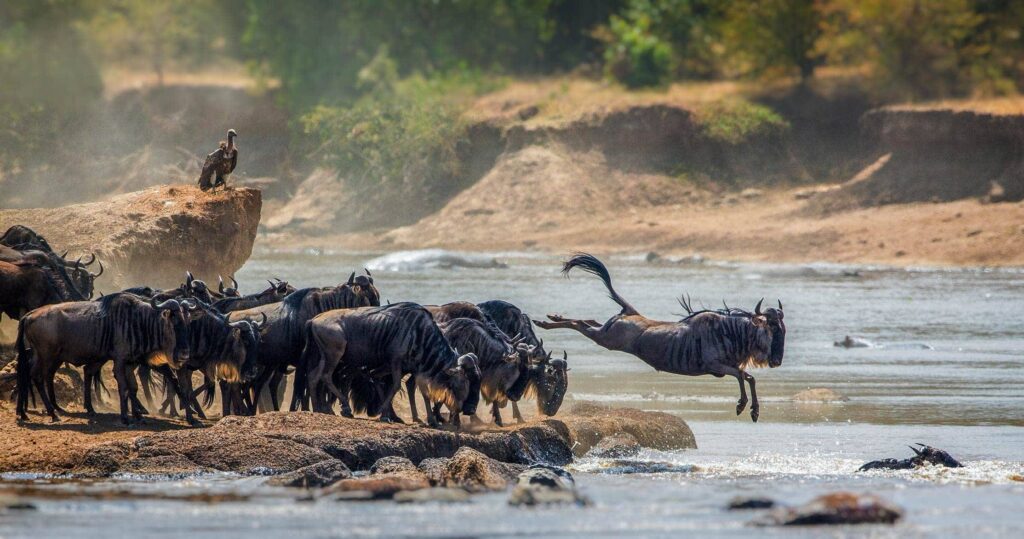Tarangire National Park : Just 43 miles (70 km) southeast of Lake Manyara National Park in northern Tanzania is Tarangire National Park. The national park is a component of the broader Manyara Area and spans an area of 1,100 square miles (2,850 square kilometers).
The national park’s name is derived from the Tarangire River, which runs through it. The river serves as the primary water source for wildlife. During the dry season, this region is traversed by the famous wildebeest and zebra migration known as the Serengeti Migration.
Tarangire is made up of grasslands, granite rock formations, a verdant river valley along the Tarangire River, marshes, and a variety of Acacia- and Combretum-based forests. The area is covered in baobab trees, which enhance the breathtaking scenery.
One of the attractions to the park is the presence of elephants, which is well known. Predator species include the caracal, cheetah, and African wild dog. A honey badger can be found in addition to the coveted lion and leopard. One of Tanzania’s lion conservation units is Tarangire.
Baboons, Cape buffalo, dik-dik, eland, gazelles, giraffes, impalas, mongooses, vervet monkeys, wildebeest, and zebras are just a few of the various animals that may be seen in the park. With more than 550 species, it is also a fantastic location for birding safaris/birdwatching.
Termite mounds are typical and found throughout Africa. The area is covered in numerous termite mounds, and the park is well renowned for its contribution to the landscape.
Tanzania’s customary safari route does not include Tarangire. This, however, also means that it is less crowded and that a more genuine African safari experience is provided. The park receives fewer visitors than the Serengeti National Park or the Ngorongoro Crater Conservation Area, in part because the wildlife is more seasonal here.
During the dry season, the Tarangire River attracts a large number of creatures from all walks of life. During the dry seasons, the wildlife of Ngorongoro is in competition with the population and accessibility of the species near the river. Oryx and Gerenuk are two wildlife highlights; however, sightings can be uncommon.
Tarangire can be a wildlife haven during the dry season and a bust during the rainy season since the richness of wildlife is cyclical. Is a component of the Tarangire ecosystem, which is home to zebra and wildebeest migration. This is a part of the wildlife extravaganza of the dry season, which can elevate the park to the top of the list of safari destinations.
TARANGIRE NATIONAL PARK SAFARI: THE WILDLIFE
The animal concentration near the Tarangire River is practically as varied and dependable during the dry months as it is in the Ngorongoro Crater. The majority of the wildlife that lives in and around the park, however, follows a localized movement pattern that maintains the ecosystem’s balance. As a result, Tarangire is excellent during the appropriate season but subpar the rest of the year. Up to 3,000 elephants can be found in the park during the busiest times, making them the main draw. Wildebeest, zebra, giraffe, buffalo, Thompson’s gazelle, greater and lesser kudu, eland, leopard, and cheetah are also present in good numbers throughout the peak season. Dwarf mongoose, Oryx, and generuk are the park’s main highlights, but sightings of these are quite uncommon. Tarangire is one of Tanzania’s finest birding destinations.
ELEPHANTS AND BAOBAB TREES
Large herds of elephants and enormous, old Baobab trees define Tarangire National Park. There are 3,000 elephants reportedly living in the park. Families in their entirety may frequently be seen congregating on the riverbanks for a drink or a bath.

Elephants in these areas grow larger than those in the nearby national parks as a result of the abundance of food and other environmental conditions. These elements have made Tarangire the home of some of the largest elephants in the world.
Another intriguing feature of the park is the baobab trees. There are several baobab trees in Tarangire National Park that are hundreds of years old; some are even over a thousand years old!
TARANGIRE NATIONAL PARK: THE BEST TIME TO VISIT
Although Tarangire National Park is regarded as a year-round safari destination, there is undoubtedly a season when animal watching is at its best.
Tarangire’s prime animal viewing months are typically from June through October (the dry season). Due to the abundance of water flowing from the Tarangire River, large herds of animals move into the park from the surrounding areas. The majority of the elephants that Tarangire National Park is so well-known for may also be found during the dry season.
Animals are more difficult to identify in the park during the wet seasons (November through December and March through May), when there is a lot of lush, green vegetation. During this time, a large portion of the wildlife disperses in search of more stable and dry terrain, especially the elephants.
CLIMATE & SEASONS
The weather at Tarangire National Park is mild, with pleasant daytime highs. Average daytime temperatures of 24 degrees and nighttime lows of 15 degrees are neither too hot nor too chilly. So if you’re going on an early-morning game drive, remember to pack a sweatshirt since it can become chilly.
The “long rains” and the “short rains” are two ways to categorize the wet seasons. The “long rains,” or heaviest rains, fall between the months of March and May, while the “short rains,” or lighter rains, fall between the months of November and December.
It rarely rains all day during the rainy seasons, only typically in the afternoon. Compared to brief showers, lengthy rains have a higher likelihood of flooding and muddy roads. The least preferred time to visit Tarangire National Park is typically this time of year. The brief rainy season is frequently great for travel.
ACTIVITIES IN TARANGIRE NATIONAL PARK
When visiting Tarangire National Park, there are a ton of fantastic tours and things to do. For instance:
- Canopy Walk
- Mto WA Mbu Cultural Tour
- Mountain bike tour
- Canoeing on Lake Manyara
- Visit the Maasai Tribe
- Bird watching
- Walking safaris
- Night game drive
- Enjoy a day of cooking with the local mama’s
ARE NIGHT DRIVES ALLOWED IN TARANGIRE?
Tarangire allows nighttime driving. But, some lodges don’t provide it since they haven’t put it up with TANAPA. Also, your particular resort won’t allow night drives if it is outside the National Park. If this is something you want, make sure the resort you are considering offers it before making a reservation.
TARANGIRE SAFARI LODGES: ACCOMMODATION
Although Tarangire’s border is surrounded by numerous lodges, we have always thought that staying in the park itself is the best option.
Swala and Oliver’s Camp are the high-end selections in the park. Kuro, a camp that is incredibly well-run and has wonderful interior decor, is one of our all-time favorite authentic options. Everyone who visits simply gushes about it. Although Tarangire Treetops is outside the park, it is without a doubt one of Tanzania’s most distinctive hotels due to the lovely rooms’ elevation into ancient baobab trees.
While Tarangire Sopa is a larger hotel, we advise choosing a more traditional and authentic safari alternative to add some special touches to your stay.
DRIVING TIME & DISTANCES
- It will take roughly two hours to drive from Arusha (NP) to Tarangire National Park.
- It takes around 1.5 hours to drive from Ngorongoro to Tarangire.
- It takes around 4 hours to drive from Serengeti to Tarangire.
- It takes roughly an hour to drive from Lake Manyara to Tarangire.
- Depending on the level of traffic, it takes 3–4 hours to drive from Moshi to Tarangire National Park.
Keep in mind that you can only drive in the parks from 6 a.m. to 6 p.m.



